J Wave Syndromes, Softcover reprint of the original 1st ed. 2016 Brugada and Early Repolarization Syndromes
Coordonnateurs : Antzelevitch Charles, Yan Gan-Xin

J wave syndromes are one of the hottest topics in cardiology today. Cardiac arrhythmias associated with Brugada syndrome (BrS) or an early repolarization (ER) pattern in the inferior or infero-lateral ECG leads are thought to be mechanistically linked to accentuation of transient outward current (Ito)-mediated J waves. Although BrS and ER syndrome (ERS) differ with respect to magnitude and lead location of abnormal J waves, they are thought to represent a continuous spectrum of phenotypic expression termed J wave syndromes. ERS is divided into three subtypes with the most severe, Type 3, displaying an ER pattern globally in the inferior, lateral and right precordial leads. BrS has been linked to mutations in 19 different genes, whereas ERS has been associated with mutations in 7 different genes.
There is a great deal of confusion as to how to properly diagnose and treat the J wave syndromes as well as confusion about the underlying mechanisms. The demonstration of successful epicardial ablation of BrS has provided new therapeutic options for the management of this syndrome for which treatment alternatives are currently very limited, particularly in the case of electrical storms caused by otherwise uncontrollable recurrent VT/VF. An early repolarization pattern is observed in 2-5% of the US population. While it is clear that the vast majority of individuals exhibiting an ER pattern are not at risk for sudden cardiac death, the challenge moving forward is to identify those individuals who truly are at risk and to design safe and effective treatments.
1. History of the J wave and J wave Syndromes.- 2. J wave Syndromes: from Bench to Bedside.- 3. Ionic and Cellular Mechanisms Underlying J wave Syndromes.- 4. Genetic Basis of Early Repolarization Syndrome.- 5. J wave Syndrome-Susceptibility Mutations Versus Benign Rare Variants: How do We Decide?.- in the Electrocardiographic and Clinical Feature between Early Repolarization Syndrome and Brugada Syndrome.- 12. Atrial Arrhythmias Associated with J wave Syndromes.- 13. Phenotypic Expression and Genetics of J wave Syndrome in the Early Stage of Arrhythmogenic Right Ventricular Cardiomyopathy.- 14. Clinical Features of Electrical Storms Associated with J wave Syndromes and Acquired Forms of J wave Syndrome.- 15. Therapy for J wave Syndromes.- 16. J wave Syndromes in China.
Dr Antzelevitch is Professor and Executive Director of Cardiovascular Research at the Lankenau Institute for Medical Research and Director of Research at Lankenau Heart Institute in Wynnewood, PA. Awards include the Distinguished Scientist Award from the North American Society of Pacing and Electrophysiology (Heart Rhythm Society), Carl J. Wiggers Award of the American Physiological Society, the Distinguished Scientist Award of the American College of Cardiology and the Distinguished Service Award of the Cardiac Electrophysiology Society. He has published over 510 original papers and reviews and seven books. He is currently Associate Editor of the Heart Rhythm journal and Secretary-Treasurer of the Cardiac Electrophysiology Society.
Provides comprehensive guidance on proper diagnosis of J wave syndromes
Demonstrates therapeutic options for the management of this syndrome
Identifies those individuals who are at risk and to design safe and effective treatments
Date de parution : 05-2018
Ouvrage de 327 p.
15.5x23.5 cm
Date de parution : 07-2016
Ouvrage de 327 p.
15.5x23.5 cm



